Welcome to a new issue of the Journal of Runic Studies, the premier Malkioni publication for studies into the nature of Glorantha. If you haven’t subscribed yet, please consult with the spirit bound to the appropriate electronic page.
This week I wrapped up one of my “Goonies in Glorantha” campaigns, with the second playtest group reaching the end next week. This is exciting: all adventurers have gone through adulthood initiation, ready for the shenanigans of cattle raiding and cult initiations. I hope to write this whole thing for the Jonstown Compendium… fingers crossed.
Chaosium News

Here are this week’s Chaosium news!
Jeff’s 2022 Projects (Part Two)
This is part 2 of last week’s video where James Coquillat interviews Jeff Richard about what he’s working on. Here’s the summary:
- After the cults book is the Sartar Homeland boxed set, which is also project that blew up in scale and size. It’s not certain yet that it will be a boxed set (especially in these times of cardboard shortage), but that’s what Chaosium is trying hard to achieve.
- There is new material on the House of Sartar.
- There are guidelines for creating your own clan, guild, or temple, including Pendragon-like management mechanics.
- Andrew Logan Montgomery (author of Six Seasons in Sartar and Company of the Dragon) has worked with Jeff on character adulthood initiations and the following apprenticeship years (also known as “the Ordeal”).
- Boldhome gets described in detail, and there’s a “campaign” booklet which goes season by season between 1625 to 1627 where the adventurers are based out of the capital city but have opportunities to participate in all the big events of the “official” timeline.
- The Dragon Pass gazetteer is there too, with the full poster-size map that Matt Ryan has done, and that we got a partial look at in the Starter Set.
- Other books include the Gamemaster Guide book, Return to Snakepipe Hollow, Pavis & Big Rubble by Robin Laws, Sun Dome County (the one in Sartar, not the one in Prax) by Jonathan Webb, and some Prax Homeland book.
- The video game that was teased a while ago is still going on, and apparently taking up a lot of Jeff’s time.
- The reprint of the board games (White Bear & Red Moon and Nomad Gods) is still an ongoing project. Chaosium is considering having Loic Muzy redo all the counters.
New Gamemaster’s Month, Week 2
Guest entry by Joerg
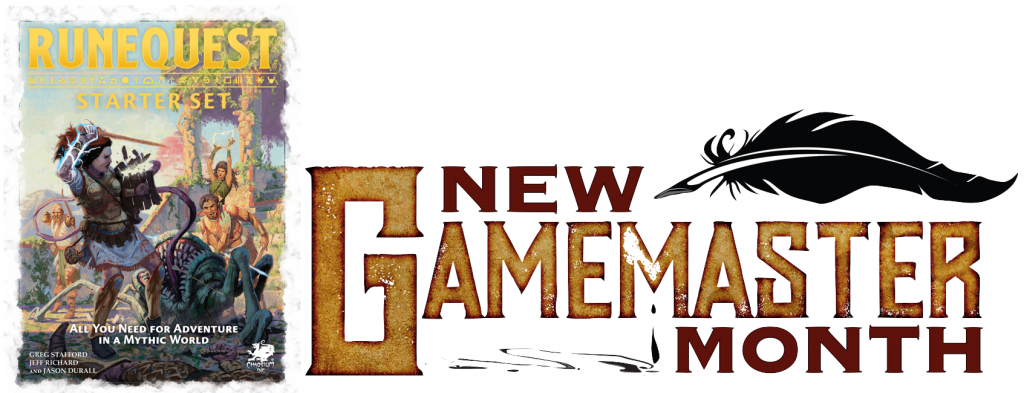
As we continue to follow the Gamemaster’s Month initiative that helps new GMs to run a game of RuneQuest, you might want to learn about the whole concept from either Chaosium or the actual project site, which will also give you the links to the Discord or Facebook groups where you can chat with other new GMs – whether new to GMing at all, or new to GMing your system of choice for this year’s project.
For lesson 3 in the course, the general lesson to the GM is to relay, and to think more about creating a game flow than to get the rules exactly right, and all the RuneQuest section asks for some re-reading of the rules after you have played through the solo adventure.
This is followed by a closer look at the first adventure new gamemasters are suposed to run. In RuneQuest’s case, that is “A Rough Landing” of course, the first adventure in the Starter Set.
ImpCon Coming Soon?
Chaosium’s online “impromptu” conventions are possibly coming back on January 22nd. Jeff Richard just tested the waters on Facebook, but given the amount of positive replies, there’s a good chance it might happen.
Who’d be up for an Impromptu Con on the 22nd? And how about if it was noonish in the US and evening in the EU/UK?
So my thought is to have a chat on RQ, a discussion of heroquesting and the heroquest rules in progress, and maybe something on the setting (how Sartar works, Boldhome, etc.). Happy to have any proposals for ideas!
It’s not official yet so don’t get too upset if the date moves or if it doesn’t happen at all, but put a tentative event on your calendar just in case!
“D&D is a Thing of the Past”
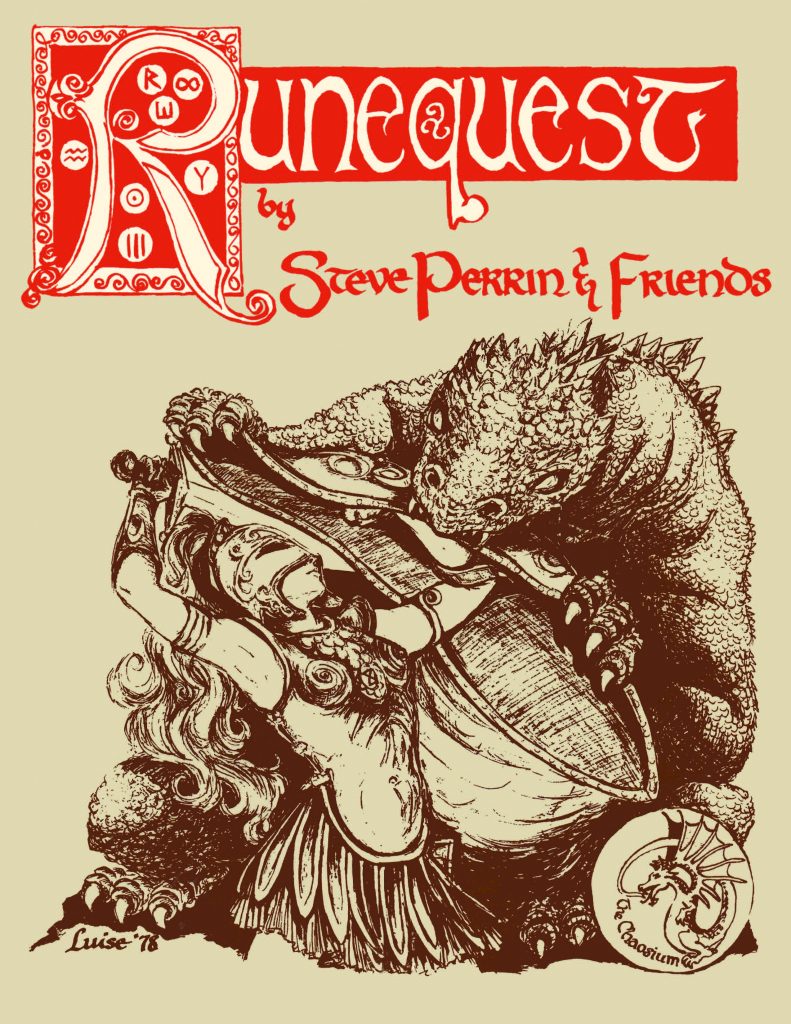
Rick Meints comes back with another “Out of the Suitcase” article about obscure Chaosium-related items. This time, it’s about an early Greg Stafford contribution to the Alarum & Excursions magazine:
In the September 1978 issue of Alarums & Excursions #37 Steve Perrin laid out, in a very bare bones fashion how RuneQuest, Chaosium’s first RPG, blazed a new trail away from the main RPG that dominated the market. RuneQuest offered a stark contrast to what many players perceived as the one true way to play a game: Experience points, Levels, Fighters can’t cast spells, Magic-users can’t wear armor, and Clerics can’t use edged weapons. RuneQuest turned that world upside down or simply chose to ignore it. Almost 44 years later, we want to share how Steve explained it all those years ago, so here is that article in its entirety
Check Chaosium’s blog for the article in question, complete with an early method for converting D&D characters to RuneQuest, campaign ideas, typesetting issues, and what the hell is a “buck roll”!
How Beyond the Pass Became Griffin Mountain
Rick gives us another “Out of the Briefcase” article already!
I played through Griffin Mountain in the summer of 1981 shortly after it was published. It’s my favorite RuneQuest campaign. Here’s the story about how Griffin Mountain came to be. As luck would have it, the actual original layout still exists, and is part of our company archives.
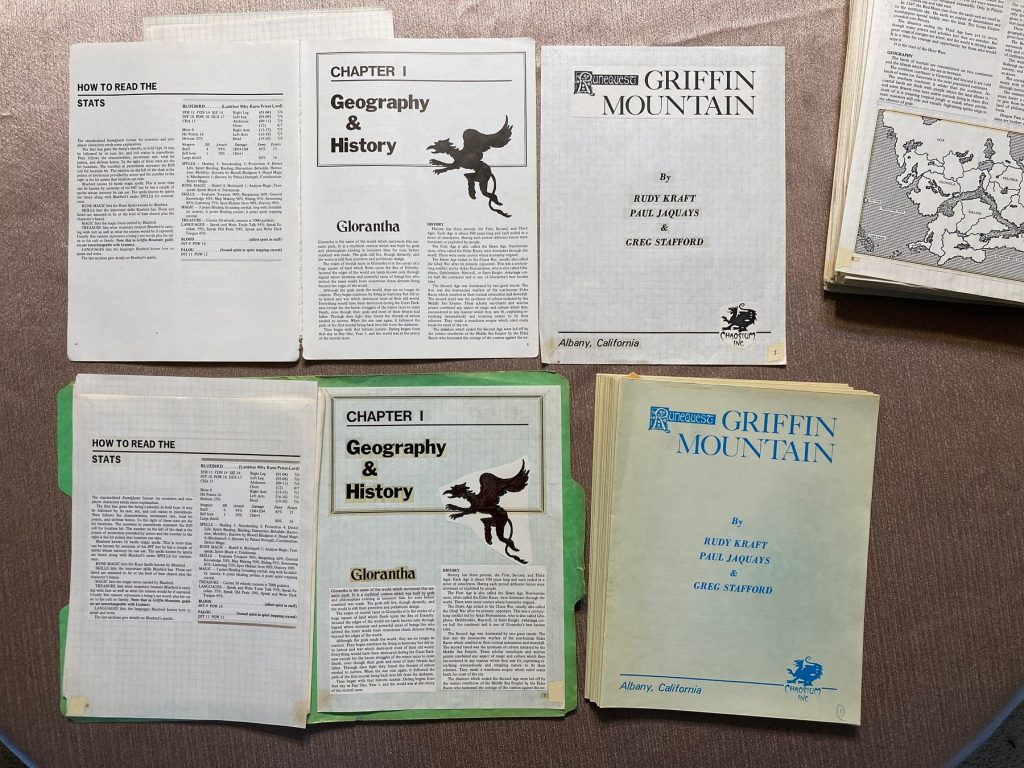
Some of the backstory behind Griffin Mountain was already included in the introductions by Rudy, Jennell, and Greg, but Rick provides a whole new look at this classic campaign, complete with multiple photos of exclusive Chaosium archives’ items. Go check it out!
Jeff’s Notes

Jeff Richard, the current mastermind on everything Gloranthan at Chaosium, is often posting notes and thoughts on the RuneQuest Facebook group. Here’s our curated list from the past week. A partial archive of these sources is compiled on the Well of Daliath.
Gaining Power Through Heroquesting
Heroquests! What is it good for? Absolutely… err, many things:
So often when we talk about heroquesting, it is in the context of gaining power, defeating a foe, exploring the mythic realms, learning magical secrets, and so on. Not surprising – that is the heroquests of the God Learners and of the post-Red Goddess Lunars. Such quests require knowledge, preparation, and magical power. They can achieve great things, but some theorize that the universe itself begins to react against them. Such heroquesters become trapped in Arachne Solara’s web unless they are very careful and respectful of what they do and where they tread.
Of course there are other more powerful contexts for heroquesting. One is desperate personal need. When one has lost everything and can lose nothing more, Arachne Solara herself shows a path through the wilderness. Such quests require true need and desperation – like that of the Red Goddess.
But the most powerful context is that of cosmic necessity. When the cosmos itself needs the hero lest part or all be destroyed by Chaos. Such quests are aided by Glorantha herself – or at least by her ghost. Some priests speculate that the full Lightbringers Quest requires both desperate personal need and cosmic necessity.
I’m gonna assume that “cosmic necessity” can work at various levels, for various levels of heroquesting and heroic gifts. A simple clan could be in dire “cosmic need”, just as the entirety of Sartar or Dragon Pass can also be in “cosmic need”… if only so that adventurers can go on justified mythic journeys appropriate for whatever is going on in the campaign at the time.
And this is why those who treat heroquests primarily as materialistic means to wrest power from the divine realm are doomed. And also why those with desperate personal need combined with cosmic necessity succeed on quests far greater than anything in the God Learners imagination.
If your players are heroquesting in order to minmax their characters, you have full license to mess them up! Yay!
The cosmos itself has spirit and/or intelligence. Call it Glorantha, Arachne Solara, Ginna Jar, or the Invisible God, but Glorantha is not a clockwork thing.
Unless you are a mostali. Then it obviously is.
Call it Glorantha, Arachne Solara, or The Gamemaster. Whichever it is, they’re going to come up with appropriate consequences!
There are some interesting parallels with elements of the 12-steps of AA or NA in some of the personal desperation quests. Common to both the Lightbringers Quest and the Red Goddess quest is a point where the quester is lost and defeated and must accept that. Only then can they continue.
Now of course, no good God Learner is going to find that an easy thing to do.
You can find these 12 steps of Alcoholics Anonymous (AA) and Narcotics Anonymous (NA) easily online, but I think Jeff is mostly referring to the classic narrative structure of the protagonist hitting a low point, acknowledging their flaws, going through some kind of transformation, and emerging victorious in their new state. I don’t imagine the God Learners did that: they probably just went through the motions to reach the God Time and then “fucked around and found out”.
The point is that not only is not every heroquest even, but not every motivation for a heroquest is even. Some motivations and psychological situations are more likely to produce results than others.
Orlanthi Expats
People in Sartar are commonly spread outside their original tribal lands:
Most of those people permanently reside in the cities – Boldhome, Jonstown, Swenstown, and Wilmskirk – and might have for generations. They are nonetheless members of their tribes.
For example, in Boldhome an approximate breakdown is as follows:
Aranwyth 350
Balkoth 200
Balmyr 350
Cinsina 500
Colymar 550
Culbrea 550
Dinacoli 150
Dundealos 250
Kheldon 900
Kultain 150
Lismelder 100
Locaem 200
Malani 300
Sambarri 350
Telmori 450
Torkani 300
Alone 200
Aldachur 350
Other 300
Note that these numbers are typically in addition to any tribal population numbers mentioned for a given tribe’s lands. So for instance, when the Gamemaster Adventures mentions that the Colymar tribe has about 12,300 people, that’s for their own tribal lands, and doesn’t include the 550 people living over in Boldhome (with possibly more elsewhere in other cities).
Also, of these 12,300 people living in Colymar lands, not all would actually belong to the Colymar tribe: spouses, expats, and guests from other tribes would make up several hundred people among that population.
The numbers in Boldhome are big: the Colymar living in Boldhome, for instance, outnumber entire clans that live in Colymar tribal lands… so their influence can’t be underestimated: when there’s a Colymar tribal meeting, there could be a whole bunch of expats from Boldhome and other cities showing up with their fancy clothes and sophisticated gifts, arguing for their own urban-driven agendas. The rural/urban divide isn’t just a modern political problem when you consider the urbanization rate of Dragon Pass!
Aha, you might say – that only totals up to 6500 people. But you have already said there are 10,000 humans in Boldhome!
Well, 3500 people in Boldhome, more than a third, aren’t Sartarite. About 2000 come from the Holy Country – say 700 from Esrolia, 1000 from Heortland, and 300 from the rest (probably mainly Caladraland). And another 1500 come from elsewhere – Grazelands, Prax, and Tarsh mainly.
There are also 1000 members of the Elder Races in Boldhome. The largest group are trolls – 675, although 300 are trollkin. There are also 200 elves in the city.
And just outside the city in the mountains are 2000 dragonewts.
Remember that Dragon Pass is a big crossroads, with a very diverse population who all have reasons to be there. Are there tensions between humans and non-humans, or between different tribes and kinship groups, ranging from petty bigotry to downright hate crimes and violence? You bet! But then again, that’s nothing new when it comes to big cities, and will hopefully be the source of many of your scenarios:
So you can see than the Kheldon actually have almost a 20% of their total numbers in Boldhome – 900 in the city and 4000 in their tribal lands. This is why the tribal manors are so important – they are places where tribesmembers can go to resolve disputes with other tribal members and where they can get support in any dispute that might need to go to the Prince.
So if your adventurer is a member of the Colymar tribe, there’s a good chance she has kin in Boldhome. And not just a few, the average Colymar clan would have 46 members in Boldhome.
When you write scenarios in Boldhome, here’s what the very high-level view looks like:
Thus in Boldhome, the Kheldon tribe are the most numerous and powerful tribe within the city. A distant second are the Culbrea and Colymar tribes, and third place is the Cinsina. Fourth place are actually the Telmori.
Everyone else is small potatoes. And periodically people have to be reminded that the Lismelder are a tribe (“the who?”).
I love the Telmori. They throw a wrench into whatever preconceptions players might have about what constitutes a Sartarite tribe. My second favourite are the Torkani, who also do that in a slightly less shocking way…
Telmori still exist as a tribe. Whether Sartar’s Peace can be reconstituted now that there is a new Prince is another question. The Telmori have not been enrolled as Kallyr’s royal bodyguard – the massacre of the Maboder and other Telmori depredations plus Jomes Wulf and the brutal reprisals against the Telmori are a lot to just sweep under the rug.
Playing a Telmori campaign where they are trying to get back in the good graces of the Prince would be interesting: they would need to justify their claims over the now vacated Wulfsland, show good faith by running missions from the Prince or for the Jonstown Confederation (we touched a bit on that in our last podcast episode), and demonstrate enough honour that Telmori bodyguards are a thing again… potentially the adventurers themselves!
Oh, and if you wonder what these Boldhome Telmori do on Wildday, when they transform into wolves, Jeff says that they stay in their tribal caves… I wonder what would happen if some bad agent was to let them out and use that as a proof that they can’t be trusted?
Storm Season, 1625
Here’s how Jeff envisions Prince Kallyr Starbrow’s announcement of her upcoming Lightbringer’s Quest:
In Storm Season 1625, Prince Kallyr Starbrow summoned an assembly in Boldhome. Before the assembled citizens of many tribes, she formally made the Lightbringers’ Summons.
Chaos stalks my world.
Broos have bruised me, the Hand has pawed me.
I have taken up the impossible path,
And seek those who must aid my task.
You are not the first of my friends.
Others walked with me to Heal.
The Devil took them, they died.
I failed to save them, Chaos grows.
According to the Book of Heortling Mythology (so take this with a pinch of salt and don’t hesitate to ignore it and make other stuff up), this is how Chalana Arroy summoned Orlanth and his friends in the God Time. Either way, it’s indeed a little speech that Lightbringer cultists, and Orlanth priests in particular, are pretty much obligated to answer, or run the risk of losing any favours with their deities. I think it only applies to Rune Level initiates, though.
But hey, remember the Proximate Holy Realm that was discussed last week? I wonder if the Lightbringers’ Summons, the Wind Lord Challenges (RQG p301), and other such “obligations”, might be part of what maintains this Proximate Holy Realm?
Any master of one of the seven Lightbringer cults must answer the legitimate call of the summons or lose all power and benefit of their god. The priests and lords present in Boldhome answer the call:
I hear and stand before you,
But I am only one.
What would you have of me?Kallyr proclaims that to stop Chaos and restore the world, she and her companions shall perform the Lightbringers’ Quest during Sacred Time, and that all who answer her summons shall aid her in the massive ceremonies and rituals that will bring the Gods World in proximity with the mundane realm. Some respond enthusiastically; other priests and lords reluctantly, fearing the dangers and consequences of the ritual.
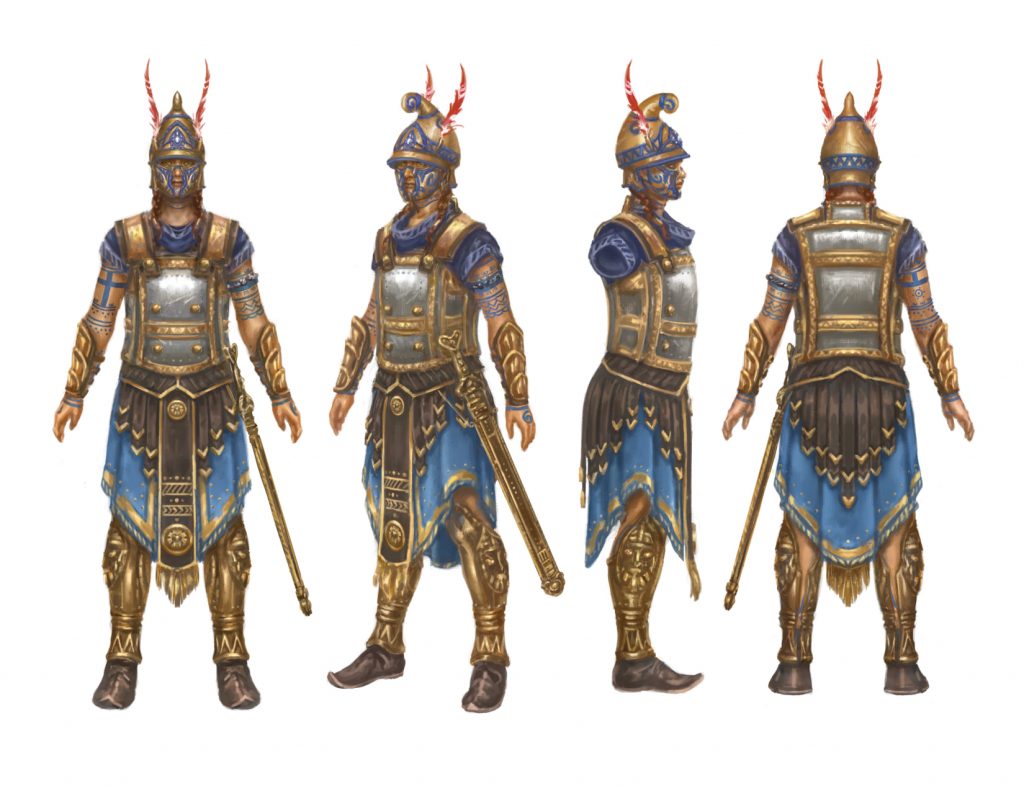
Now I want you to imagine how radical an event that was. Although components of the Lightbringers’ Quest are incorporated into Sacred Time celebrations, that is not what the Prince is proposing – she wants to perform the LBQ herself. No Sartarite leader has tried that at this scale – not Sartar, not Tarkalor, not even desperate Salinarg.
She’ll need the support of thousands to bring the divine realm into proximity, and she’ll need magical items, spirits, and blessings – and that support won’t be available for the usual needs.
I already mentioned how it’s quite unclear to me how much “magical support” you need to go on a heroquest…. can you start an LBQ with a piece of string and two sticks? Would it not work at all, or would it be a hundred times more dangerous and unstable than if you had entire tribes behind you?
Anyway, in this case, the tribes are being asked to provide support, which would divert resources from their own Sacred Time ceremonies to improve harvests and pregnancies and whatever… and many of these tribes have paid dearly for Kallyr’s violent rebellion against the Lunars.
But it is a valid Lightbringer Summons by someone with the authority to give it to all the tribes. So what do you do? What do you urge your kin to do?
Jeff adds a few comments for context:
However, it is worth keeping in mind that at this time, [Kallyr] has been Prince for no more than two seasons. Her last liberation of Sartar lasted just about this long. There are other tribal leaders and warlords who barely acknowledge her authority, and there is another warlord in Prax with an army of nomads.
So it is a damn high stakes play for someone without a lot of cards. No room for error, and everyone knows it.
But she’s succeeded in unlikely circumstances before, and she IS Prince. So what do you do?
And:
Regardless of the success or failure of her quest, the magical energies summoned successfully brought the divine realm into proximity with Sartar, at least for the duration of Sacred Time. Hers was not the only heroquest that took place during those two weeks!
By definition, everybody is heroquesting in some form or other during Sacred Time, but I assume Jeff is referring to Argrath here.
Now Kallyr tries to limit the dangers of the Lightbringers Quest by truncating its most dangerous parts, by having stand-ins at key points and containing it within her realm. She does not go to the Western Shore – people will carry her on shell-back, and others will represent the Luathelans. She hardly enters the Underworld, keeping the path to what she knows. And the ritual will culminate in the Royal Palace of Boldhome, with a polluted statue representing Wakboth (to be destroyed ritually by the participants).
Having stand-ins for as many figures as possible is actually a great tactic: my players did exactly that for their first heroquest in one of my campaigns, and it severely reduced the risks (at least as long as they picked people who could truly identify with the figure they’re supposed to stand-in for). They still had a few surprises of course, but it was an interesting exercise in improvisation.
But the Bad Rain needs to be summoned, and various foes and enemies are summoned by the magic. The dangers are real – just mitigated, hopefully.
We have already discussed the Bad Rain, which is what happens when Orlanth is brooding, thinking of how his mistakes brought the Great Darkness and all its monsters… and so you’ve got monsters literally showing up.
The idea is that by bringing the divine realm into proximity, even these stand-ins will successfully bring magic into the world. This approach was common to many heroquests in Dragon Pass or the Lunar Empire (an example of it was in Cults of Prax, with a Yelmalio Rune Lord performing the Three Blows of Anger). Perform the quest as a ritual within the Proximate Holy Realm, and it should bring forth the intended magic without as much danger.
What she did not know is that Jar-eel had learned how to use that Proximate Holy Realm as a highway, and that she could enter among the stand-ins. This came as quite a shock to Kallyr and her household (although it is something that Argrath was already aware of, having encountered that in the past and even exploited it to his advantage on several occasions).
Now if we go back to how heroquests are best performed (when you’re at rock bottom), we can see why Kallyr’s LBQ didn’t start with the best chances:
Kallyr pushes for the LBQ at the very height of her power. Argrath tries at its nadir.
Sacred Time, 1625
By now, most people (even the newbies) will have gone one to 1626 or 1627 at least, but if you want to start another campaign, Jeff has some ideas:
Because of the magical energies released as part of the preparations for the Lightbringers Quest (and perhaps because of the awakening of a True Dragon with the Dragonrise), much of Sartar could be said to be on the Hero Plane during Sacred Time of 1625. While Kallyr and her companions traveled about Sartar performing the Westfaring and Descent, there were manifestations of the divine realm throughout the realm. Many people reported seeing battles in the sky, burning footprints, marching trees, the Night Wolf, and the Black Eater. A few saw stranger things, like the Stream being filled with corpses or the Three Feathered Rivals. One even claimed to have found herself at the edge of the world.
Such manifestations and events became increasingly common during the Hero Wars, as even greater releases of magical energy occurred.
The Westfaring and the Descent are the first two big phases of the Lightbringers Quest, which Kallyr Starbrow tried to perform after the Dragonrise to restore cosmic balance in Sartar or something. I don’t know, people in Glorantha use the LBQ for the most convoluted reasons sometimes…
That said, these are cool epic manifestations that Jeff mentions here. Again, this is the stuff I need to be better at to give some mythical dimension to my games. However I’m afraid it only comes with either (1) deeper Gloranthan lore knowledge or (2) deeper familiarity with real-world myths? We’ll see…
I post this in order to provide some opportunities in your game (this is going to be presented in far more detail in the Sartar Book). In Sacred Time 1625, you can have your adventurers see a battle in the sky – and maybe even participate in it – or maybe meet an imprisoned or broken deity, or witness marching trees or whatever. They might get something new and magical from the experience. They might even decide that they want to explore the mythic realm more!
Jeff adds some comments about Kallyr’s heroquest:
It is thought that Jar-eel was able to exploit the Proximate Realm to manifest herself in an unexpected manner during the Lightbringers Quest. If true, this would be a stunning tribute to her power and her mythic virtuosity – as appearing in more than one place at the same time is sign of divinity. Tosti Runefriend later speculated that Jar-eel might have Discorporated, entered the hero plane, appeared in the ceremony, and then manifested physically – but such magic is godlike and perhaps the counter-explanation is even more frightening than just saying that Jar-eel is the incarnation of the Red Goddess.
Jar-eel’s intrusion into Kallyr’s heroquest is featured in Jeff’s “While Bull Campaign”, which is available on YouTube. I always assumed that Jar-eel showed up because she heroquested the same myth at the same time (based on information from spies in Kallyr’s entourage), or used a magical road to the heart of Sartar, or something… I would not have guessed she used the Proximate Holy Realm, especially since I didn’t even know about it until last week anyway.
My current understanding is that running your own heroquest and hoping to get “matched” with someone else’s heroquest has a low hit rate, and you show up as a certain mythic figure, which might be good in some cases, but potentially limiting (and a little bit insulting) for someone like Jar-eel. She wanted to intrude as herself, or maybe as the Red Goddess — neither of which feature in the Lightbringers Quest.
Jar-eel’s willingness to tread very dangerous paths and embrace even more dangerous associations proved to surprise the Orlanthi, who could not imagine a mortal would be able and willing to do what she did.
More Heroquesting
I guess that’s the theme this week — maybe an indication that Jeff is tweaking the heroquesting rules for the Sartar Homeland scenarios? Anyway, here it is:
One of the great benefits of heroquesting is the ability to gain magic outside of what can be gained from one’s cult. These magic abilities often operate mechanically similarly to Rune spells. Sometimes these new spells can be incorporated within the cult structure, creating a new subcult. For example, Garundyer gained the spells of Hailstones from Siglolf Cloudcrusher – these spells form the basis of the Cloudcrusher subcult of Orlanth Thunderous.
A subcult of a subcult? Hah! But more seriously, I’d love to see some player character heroquest deep enough to bring a new Rune Spell and start a new sub-cult.
Alternatively, these new spells can form the basis of a new cult similar to a Spirit Cult. Hon-eel brought forth Bless Maize which became the basis of her cult. Argrath brought forth the White Bull which has become a popular Spirit Cult in Prax.
Oh, I guess the player character needs to do some really hard-core heroquesting then.
Most often, these new abilities are personal to the quester. Sarostip has the ability to kill with his left eye. Hofstaring had his flying spear. Jaldon Goldentooth has his ability to bite through walls. Harrek has his God-Spirit White Bear Cloak. Many heroes possess the ability to return from the dead or to Discorporate their spirits.
The best way to give player characters a good heroquest power is to work with the player, and agreeing on a power that feels right.
The distinctions between these approaches and why an ability gained on a heroquest might be personal or might be incorporated into a cult can get more than a little fuzzy or contradictory, but there are certain generalizations. Powers gained on quests where the hero travels in the footsteps of their god are easiest to incorporate into their cult. Powers gained on new quests that can be repeated but are outside of the mythos of the cult must become a new cult. And powers not shared with others remain personal.
Now I say these often operate similarly to Rune Magic, but it is also possible to gain powerful Spirit Magic as well. Spirit magic that does not count against spell holding limits, or is of permanent duration is well known, although such abilities are always personal.
And a few of the powers or side effects gained through heroquests don’t fit into either Rune Magic or Spirit Magic. The best known is of course unaging, but also things like lack of shadow despite the sun, no sweat (while being unaffected by heat, cold, or exertion), and so forth.
It is important to keep in mind that abilities gained through heroquests are exceptions to the general rules of magic. They are examples of direct interactions with the raw source of magic, rather than the more formulaic expressions of rune magic, spirit magic, or sorcery.
Let’s Count the Yelmalions Again
There are about as many Yelmalio cultists in Sartar as there are in Prax’s Sun County. And twice as much among the Praxian tribes themselves, or in Tarsh:
In all of Dragon Pass there are about 18,000 Yelmalio cult members. That’s:
6000 in the Sartar homeland (largely concentrated around the Sun Dome, Alda-Chur, and Boldhome).
12000 in Tarsh
Negligible numbers elsewhere.In the River of Cradles there are about 4500 Yelmalio cult members, with about 4000 in Sun County and 500 in Pavis County.
For comparison, in all of Dragon Pass, there are about 111,930 Ernalda cultists, 85,000 Orlanth cultists, and 66,500 Seven Mothers cultists.
There are about 8700 settlers in and around Alone. About 2000 Orlanth cultists, 2000 Ernalda cultists, and about 300 Yelmalio cultists. 275 Maran Gor, 250 Humakt cultists, and about 130 of each of the other Lightbringers.
Alda-chur Population
As Jeff seems to be going through his spreadsheets, he’s turning his attention to Alda-chur, in Northern Sartar:
There are about 31,000 permanent residents in the area centered on Alda-Chur, including the Dinacoli, Princeros, Tovtaros, and Vantaros tribes. This area, called the Far Place, speaks Tarshite but has had close economic and political ties to Sartar since the foundation of the Principality, and joined the Principality shortly after the Battle of Grizzly Peak.
The ten largest cults in the Far Place are:
5825 Ernalda
5300 Orlanth
1700 Yelmalio
1600 Seven Mothers
600 Engizi or Heler
520 Storm Bull
500 Humakt
470 Issaries
435 Maran Gor
380 Daka Fal
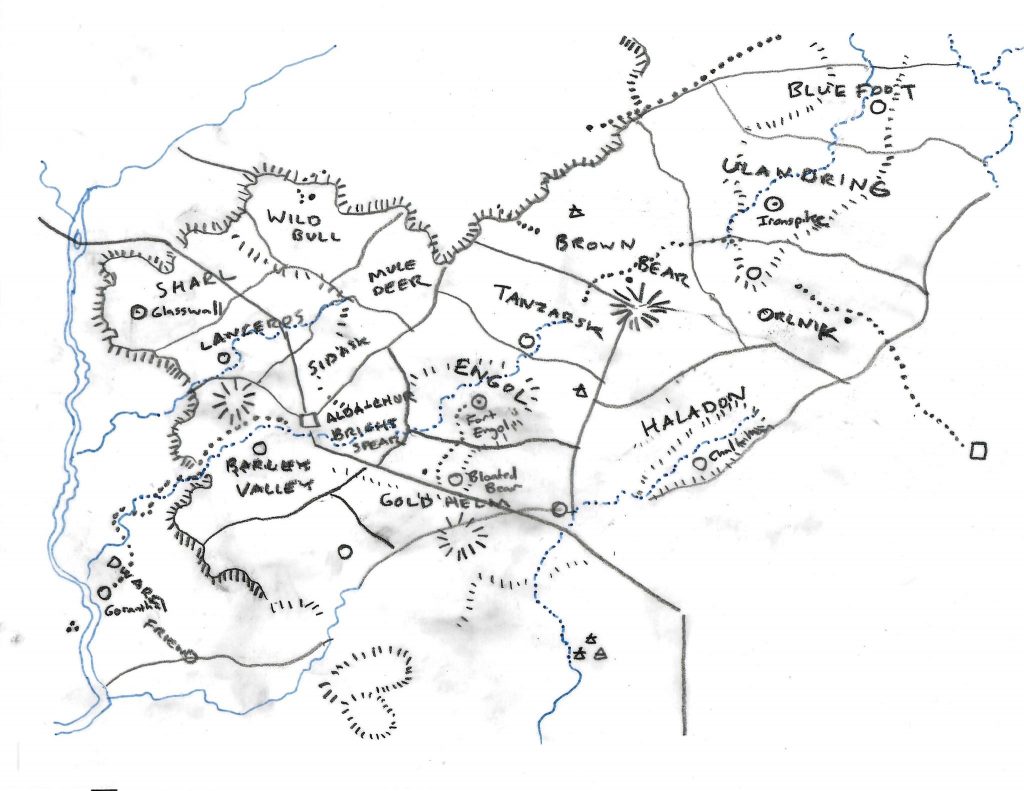
The Dinacoli clan is further south: it used to be part of Sartar, but around the time of Kallyr Starbrow’s rebellion in 1613 (which they did not support), they changed their allegiance to Alda-chur.
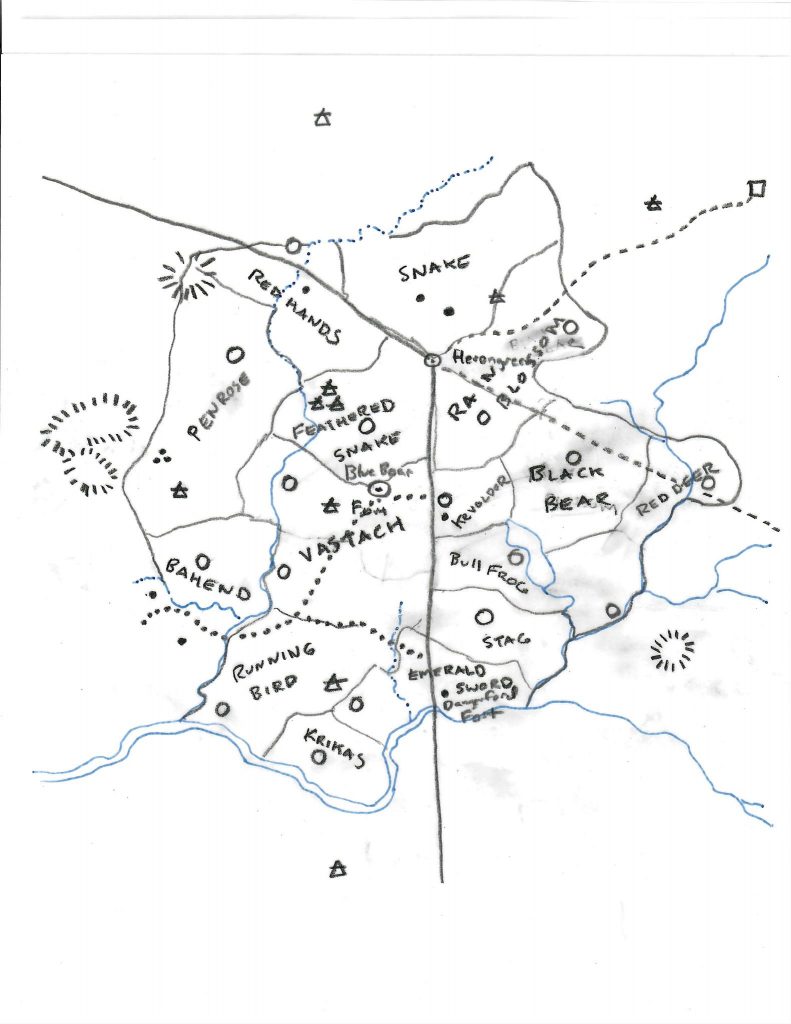
The close proximity with Snakepipe Hollow, a well known Chaos-infested area neighbouring the northern-most tribes, means that there’s a high presence of Storm Bull initiates at any point. But there’s a high turnover:
[…] many are not residents. It is not uncommon for bands of Pol-Joni Storm Bull cultists with their Praxian allies to come to Snakepipe Hollow to fight Chaos.
As of 1625, the Alda-chur Confederation is still under the indirect rule of the Lunar Empire through Harvar Ironfist, a Yelmalion Rune Lord who violently took power in 1611. Depending on your timeline, Harvar might have been eaten at the Dragonrise, but his forces might still be in power despite this. I think that in Chaosium’s Glorantha, the area is only freed a bit later when Argrath starts to move into Dragon Pass.
Personally I would have Harvar simply send some representatives to the Lunar Temple opening ceremony and subsequent destruction, which leaves open a cool showdown between himself and Argrath… or the adventurers…
Anyway, all of this to say that the area is still a Lunar colony in 1625:
And given that Storm Bull hates the Red Goddess as much as Orlanth does, imagine the consternation caused when a band of 100+ mounted Storm Bull cultists show up on a sacred quest to hunt and destroy Chaos. Can’t act against them – Storm Bull is beloved for keeping Chaos out of the Far Place – but can’t really allow them to stay.
Harvar Ironfist is from the Vantaros tribe, which is where the bulk of his Yelmalion hoplite army is from:
Of the 1700 Yelmalio cultists, 1400 of them are either in Alda-Chur or among the Vantaros tribe.
So how, you might ask, could 1700 Yelmalio cultists dominate a tribal confederation with 5300 Orlanth cultists? Three things:
1. The Yelmalio cult was more centrally organized, with Harvar able to gain their support and defeat foes piecemeal.
2. Harvar had strong Lunar support. Money, mercenaries, you name it.
3. His rule was pretty tenuous once you got outside of Alda-Chur and the Vantaros tribal lands. The other tribes paid tribute and stayed out of trouble.
I would also assume that about 2/3rds of the Orlanth cultists are farmers belonging to the Thunderous or Barntar subcults: they know fighting only as far as the tribal militia membership goes. The Yelmalions are pretty much all professional soldiers, and are much better individually trained, in addition to what Jeff said about them being better organized as a whole.
Back in 1611, Harvar brought in Gagarthi warbands (plus maybe some miscellaneous other mercenaries) to seize power violently, getting rid of several Orlanthi leaders. Once those are gone and most of Kallyr’s rebellion fled far away south or east, there probably wasn’t enough motivation left for anybody to organize a serious uprising anyway. So yeah, most of these tribes pay tribute and stay out of trouble… except for the the tribes around Alone, maybe, because that’s where my players are, currently in 1615, fresh out of their adulthood initiations and ready to kick some ass!
Around the River of Cradles
Let’s have a look at the farming people around the River of Cradles, aka the Zola Fel which runs through Prax:
[…] Lets start by remembering that those that Dorasar encountered (and made himself ruler or overlord of) were the descendants of settlers that had been isolated from Dragon Pass for over 400 years.
To place things in historical context, Dorasar founded New Pavis in 1550. The Dragonkill War which started the Inhuman Occupation (when no humans lived in Dragon Pass) happened in 1120, so that’s what I think Jeff is referring to.
However, the return of human settlements in Dragon Pass started in the early/mid 1300s, with Heortlings like King Colymar coming from the south to settle the first Sartarite tribes, Arim the Pauper coming from the north to found the Kingdom of Tarsh, and the Pure Horse people coming from Prax in the east. I’m not sure how “isolated” the people of the River of Cradles would have been even after three generations since the foundation of the Kingdom of Sartar (in 1492), which, given Sartar’s modus operandi, would have had some good trade going on by then.
My guess is that trade with Prax was limited, or even non-existent. The Grazelanders, still traumatized by their defeat and subsequent exile from Prax in the mid 1250s, might have told horrible stories about the Praxian nomads to the Sartarites, stories that might have stuck in everybody’s mind well into the 1400s, if not later. And the Sartarites might have been more interested in lucrative trade between the Holy Country and Tarsh anyway. The few brave traders who had the idea of checking out what can be done to the east might have come back robbed of all their stuff, including a few limbs: “don’t go to Prax, there’s crazy nomad people there“.
Think of them like some of the Greek communities in Central Asia that survived the collapse of the Hellenistic empires, or like the Crimean Goths. Isolated, tenaciously defending their identity from the Praxian nomads and the trolls, refusing to become another “Oasis people”.
So effectively, the violent and conservative Praxian tribes might be what isolated the Zola Fel settlers from Dragon Pass.
They succeeded, and the Yelmalio cult was key to that. But during the long period of solitude and isolation, that cult dwindled and diminished. Perhaps only about 1000 cultists survived to great Dorasar and Varthanis Brighthelm. By that time, the Yelmalio cult was little more than a Spirit Cult, associated with a Grain Goddess, who he defended from nomads and trolls, and friendly with the local river nymphs. They had a big temple they could hardly maintain and stories of Yelm the Sun God, whom Yelmalio defended and was the son of.
It sounds like the original River of Cradles version of the Yelmalio cult was, by necessity, an increasingly xenophobic (towards the Praxian tribes) and conservative affair.
Varthanis brought them the Yelmalio of Monrogh Lantern. With gifts, geases, more spells useful for fighting trolls, and brought them into contact with Dragon Pass – which meant bronze and allies. The Grain Goddess became recognized as Ernalda, but that also brought in rivalry with the Orlanth cult brought to Pavis by the Sartarite settlers. The population of the farmers grew and the Yelmalio grew to dominate Sun County.
Varthanis was a Yelmalio companion of Dorasar, so he arrived with many of the new doctrines “discovered” in Dragon Pass when Monrogh Lantern helped the Sartarite cult of Elmal evolve into the more modern cult of Yelmalio.
But this area was a periphery. Contact with Dragon Pass was largely through Pavis, not Sun County, and even Pavis is a frontier settlement. If Pavis is our Wild West town like Santa Fe then Sun County is even more remote, one of our more successful Spanish missions.
This all sounds like good world-building that paves the way to the Sun Dome book in Sartar presenting a widely different take on Yelmalio compared to Prax…
Keeping Your Adventurers Prisoners
On Facebook, Wesley Samsal asked about the old “slave bracelets” that are mentioned for instance in Cults of Prax. These used to act as magic dampeners, preventing people from using magic. As far as I know, they’re not “canon” anymore so how do people keep other people prisoners? Jeff has some answers:
Characters with Honor aren’t going to escape if they are being ransomed. Given the importance of Honor in Orlanthi culture (and Lunar military culture), the broad assumption is prisoners aren’t killed, but they don’t try to escape. And your community rarely is going to reward you for breaking the rules.
This answer of course assumes the most common situation, which is: the PCs fought some NPCs, the fight didn’t go well, and the players decided to surrender and invoke their ransom (the sum mentioned in the Occupation chapter of RQG, p63-73 is usually good enough, but throw in a bag of chips or a box of chocolates to the gamemaster, for good measure).
If you escape from captors you surrendered to, then those captors will not trust other folk from your community. Which can be a very bad thing.
The whole purpose of the ransom system is to avoid killing people defeated in combat or war. Several powerful war cults strongly uphold it – breaking those rules can make other dangerous enemies.
Ransoming someone back usually only requires keeping them captive for a few days, but other situations might involve keeping them as “non-free tenants” (or similar) for longer, such as someone working off their defeat and capture in battle for a season, a year, or more. I imagine this is more common for prisoners of war, from a defeated army, than for someone being captured after a cattle raid or highway robbery… but I think similar guidelines apply either way.
So if your players surrender only to escape a bit later, the following comes to mind:
- If possible, have a messenger already on their way to the PCs’ community to get the ransom. The first thing captors will do is probably ask where the funds are, and send someone there. That could be one of their own but, preferably, the messenger is one of the PCs’ companions, if applicable, or a third party, I think. Now the PCs have to intercept this messenger, otherwise they will not only still have paid their ransom, they will also have a very awkward and humiliating situation on their hands.
- If the PCs escape and get out of paying a ransom, word gets around and a couple seasons later a handful of people from their community get killed instead of being ransomed back. The killers will of course have left a clear message: “the last people we captured sneaked away like dishonourable tricksters, even though they didn’t carry his marks… we’re not taking any chances this time: we’re taking our ransom from their dead bodies“. The PCs will have to restore their standing with their community if they want these new spells or skill training. This is especially true if one of those killed people carried an important tribal item!
- Of course this is Glorantha so you can always bring in angry spirits: that ancestor who was big on honour, some cult spirit that thinks you’re not worthy anymore, or worse.
Not all consequences are bad, though! People might be interested in the PCs’ lack of respect for traditions. Some Chaos cult might approach them, which I’m sure won’t lead to anything problematic, right?
Kyger Litor Isn’t Your Friend
Jeff reminds us that the cult of Kyger Litor is hostile to a whole bunch of people:
ALL the Seven Lightbringers (including Chalana Arroy)
ALL the Lunar cults (except the Red Goddess who is an Enemy, Yara Aranis who is Neutral, and Jakaleel and Annilla who are Friendly)
Aldrya, Basmol, Caladra and Aurelion, Dayzatar, Flamal, Lodril, Lokarnos, Lowfires, Ourania, Polaris, Pralor, Rathor, Shargash, Telmor, Yelm, Yelmalio, Yelorna
Her enemies are the gods of Chaos (all of them), the Red Goddess, and Mostal.
So as far as the Mother of Trolls is concerned, Orlanth is as bad as Aldrya, Yelm, Yelmalio and the Seven Mothers. But she will cooperate with any of those against Chaos (which includes the Red Goddess). Of course afterwards, she will likely to devour her erstwhile allies, so you take your risk.
It’s interesting that Kyger Litor cultists don’t even like Chalana Arroy. They have their own healer deity (Xiola Umbar, I believe), but still, healing is healing. Apart from that, I assume that Lightbringer cults are hated for their association with Orlanth, who slew the sun god and forced trolls to flee the Underworld, Solar cults for obvious darkness vs light reasons, and Lunar cults and miscellaneous ones like Telmor for their association with Chaos.
As always, those are generalizations. Your particular Troll adventurer might have a personal history that, despites their Kyger Litor cult membership, makes them somewhat friendly to, say, other adventurers belonging to Lightbringer cults. Adventurers are often exceptions after all. Buf Jeff gives some better advice:
So smart Lunars try to approach Kyger Litor through Jakaleel or Annilla if possible. Smart Orlanthi try to approach her through Ernalda or Humakt (who are Neutral) – or Argan Argar or Storm Bull (who are Friendly).
I could imagine a duelling group of delegates to the Castle of Lead – a Lunar group with Blue Moon cultists and an Orlanthi group of Storm Bulls and Earth Priestesses. Both have about the same chance of success (unless the Lunars are dumb enough to hail the Red Goddess).
I think the politics and spygames around the Castle of Lead’s agenda in the Hero Wars have been quite underused so I’m always happy when it crops up like this!
Community Roundup
The community roundup is our highlight of interesting things being mentioned in the Glorantha-related Facebook groups, sub-Reddits, and other similar online places.
Beer With Teeth’s Self-Publishing Advice
Friend of the show Diana Probst posted some in-depth article about self-publishing gaming material on DriveThruRPG (and elsewhere), based on their experience with Chaosium’s own Community Content Program. It’s full of good advice!
Assortment of Painted Miniatures
Jonathan Tarry has a bunch of nicely painted miniatures. The Sable Rider and Primal Chaos Devotee are from Mad Knight.
Austin Conrad’s Final Thoughts on MOTM
Austin has written a blog post about his final issue of Monster of the Month, and the end of the series:
Ultimately, I’m not canceling MOTM because I want to stop writing RuneQuest material. I’m canceling MOTM because I want to write better material.
Plus, lots of designer notes about that last issue, To Hunt A God.
When Razalkark Enters The Scene
Bruce Clegg found a good miniature stand-in for Razalkark, the Unicorn Broo leader of Dorastor!

The miniature is actually of Apollo, from the Grandville comic books (it’s great!), but it works pretty well in Glorantha too. You can check it out at Crooked Dice.
Handling Group Climbing
SkullDixon discusses group climbing on his blog. Interestingly enough, he adopts the reverse approach from my own Runic Rant article on the more general idea of group rolls: instead of having characters help a “leader” through augments, SkullDixon has the “leader” augment everybody else’s rolls.
WeaveTheTale Plays RuneQuest
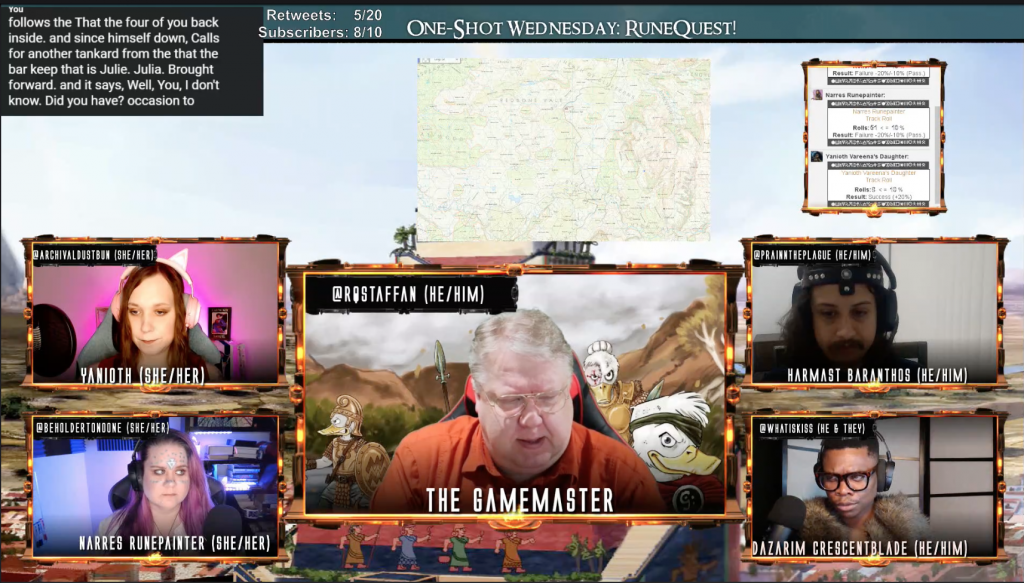
The WeaveTheTale channel played a RuneQuest one-shot this week, with RQStaffan as the gamemaster. You can watch the game on Twitch, but I assume it will show up on their YouTube channel soon enough.
Elsewhere on Arachne Solara’s Web
Not everything is about Glorantha, although most things are! Here are loosely relevant things that we found on the interwebs.
Ancient Table Manners
Guest entry by Joerg
If you want clues about housing and everyday obects, this German language website has thousands of photographs showing actual artifacts and reconstructions for several cultures – Romans, Greeks, Etruscans, Celts, Germanics, Iberians, Egyptians, and a few others with less documentation. Romans and Greeks are best documented.
There are sub-pages on the house, the furniture, table-ware, food selection and preparation, table manners (like us of hand-cloths in Roman depictions).
Most sources are Iron Age rather than Bronze Age, but they should give some impression what you might find in Glorantha.
It won’t hurt to look for sources outside of Mediterranean and central Europe, though. A recent video on the Tlaxcallan culture in Mexico before the arrival of Cortes discusses and shows some impressive table ware 8:20 minutes in.
Thank you for reading
That’s it for this week! Please contact us with any feedback, question, or news item we’ve missed!



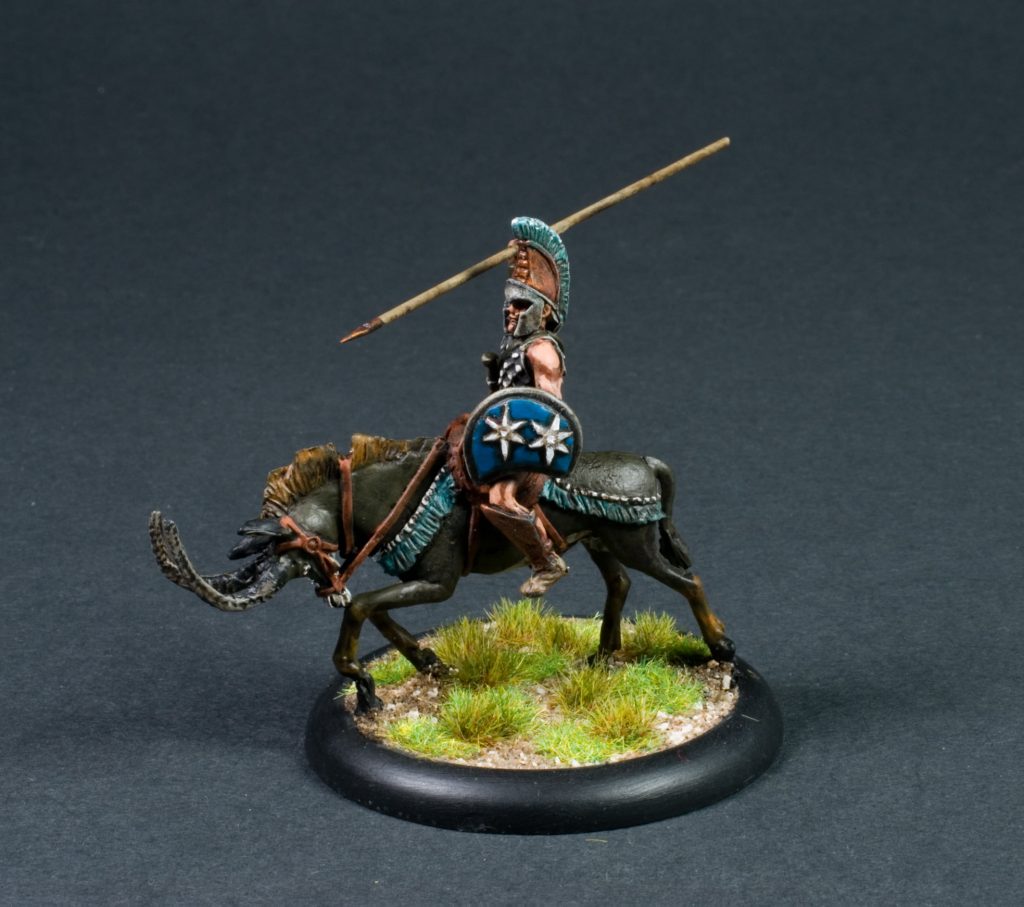

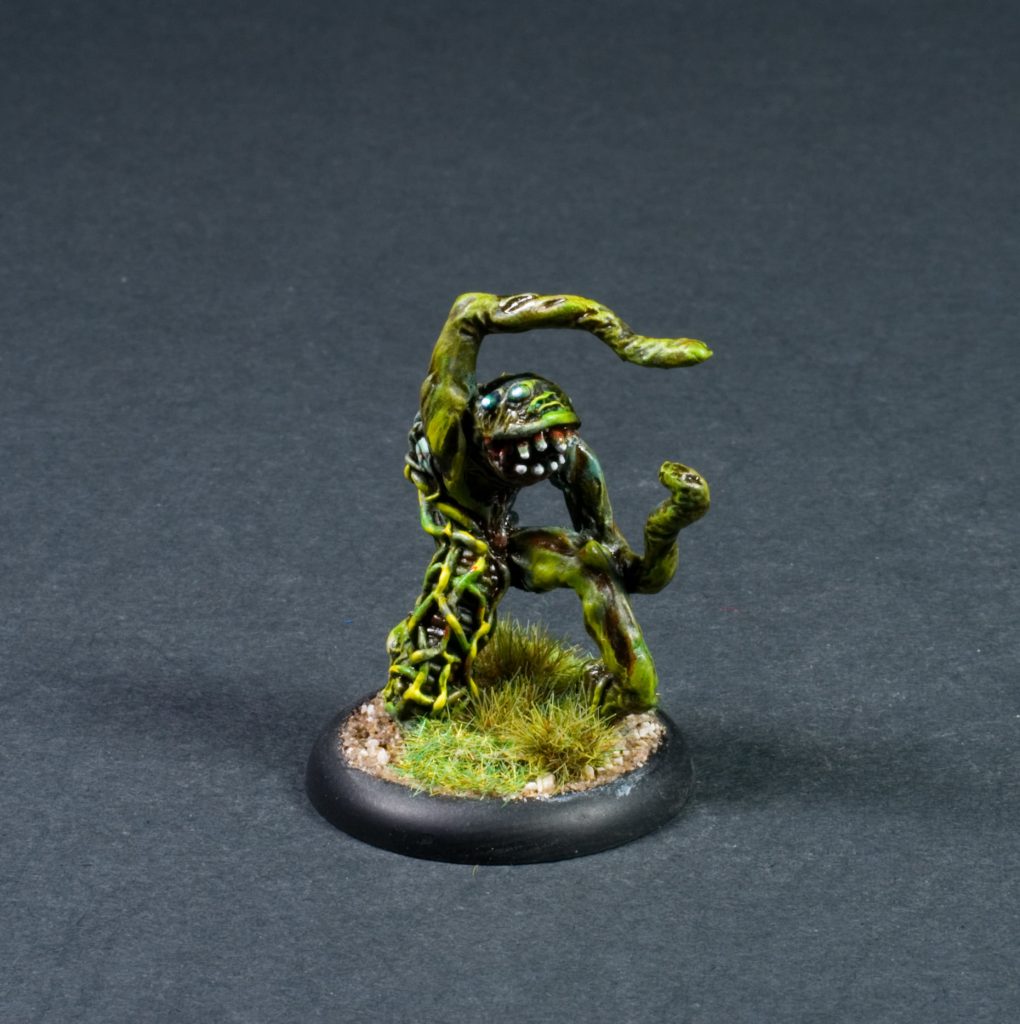
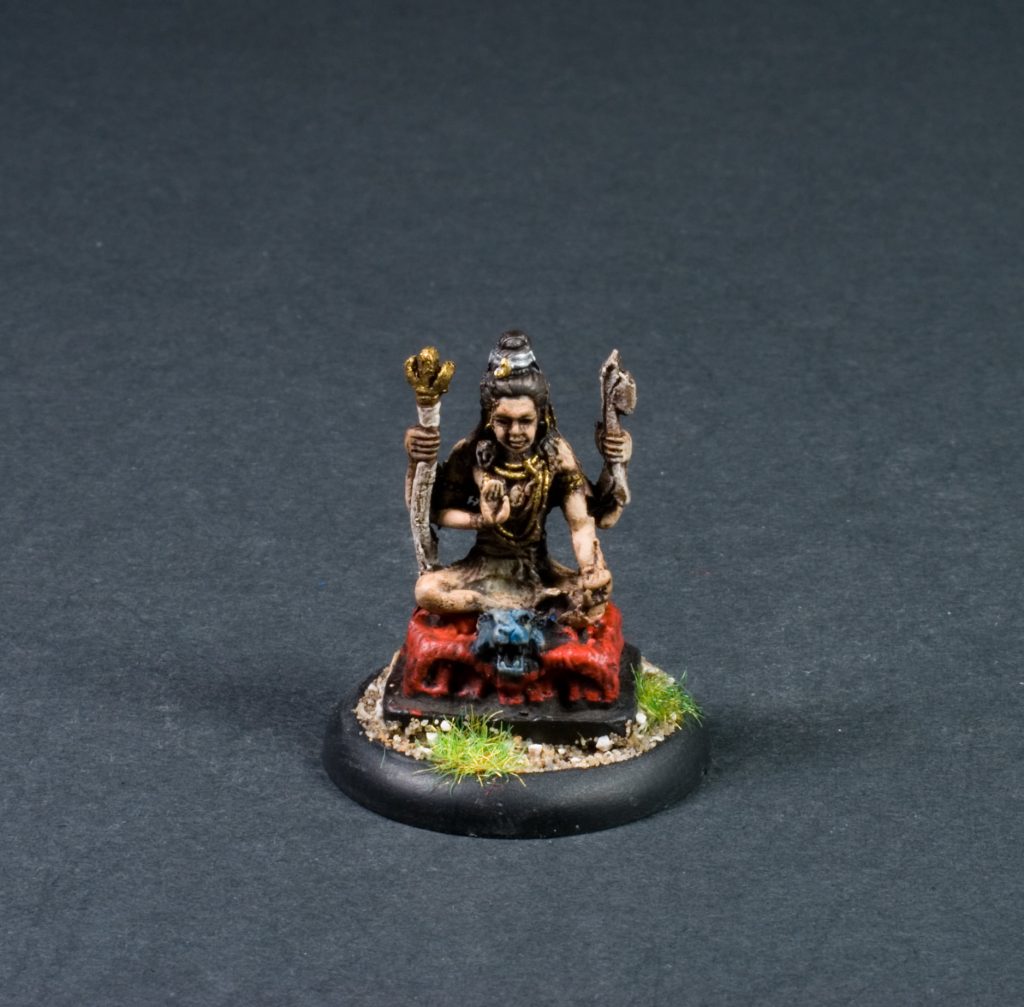
One comment on “Journal of Runic Studies #31”